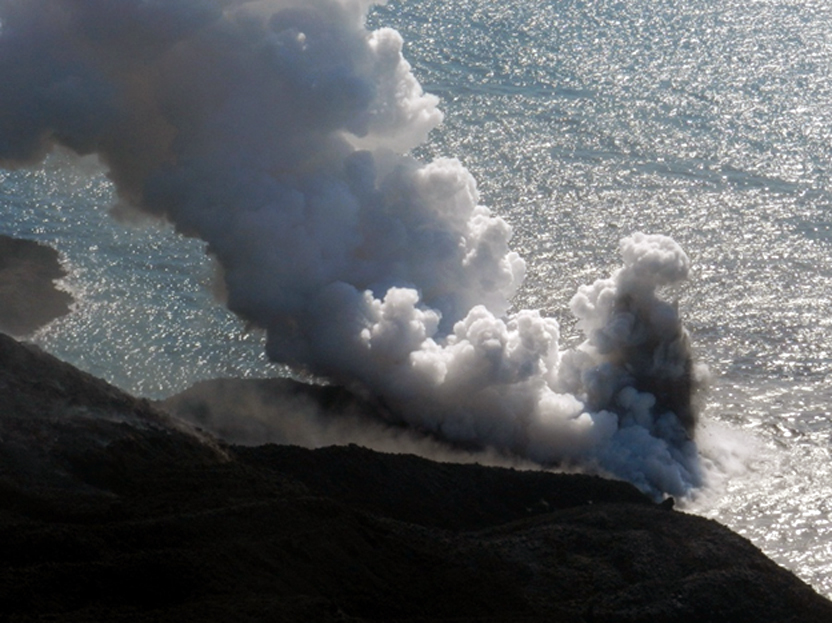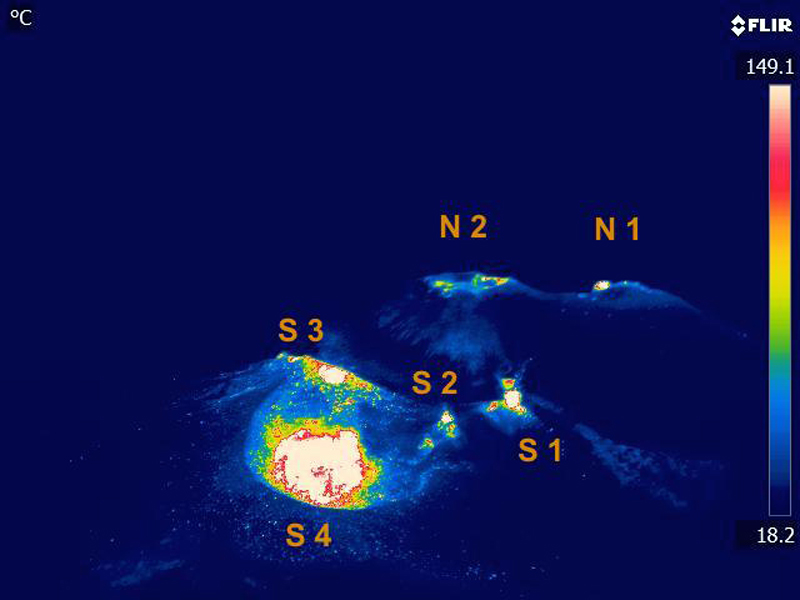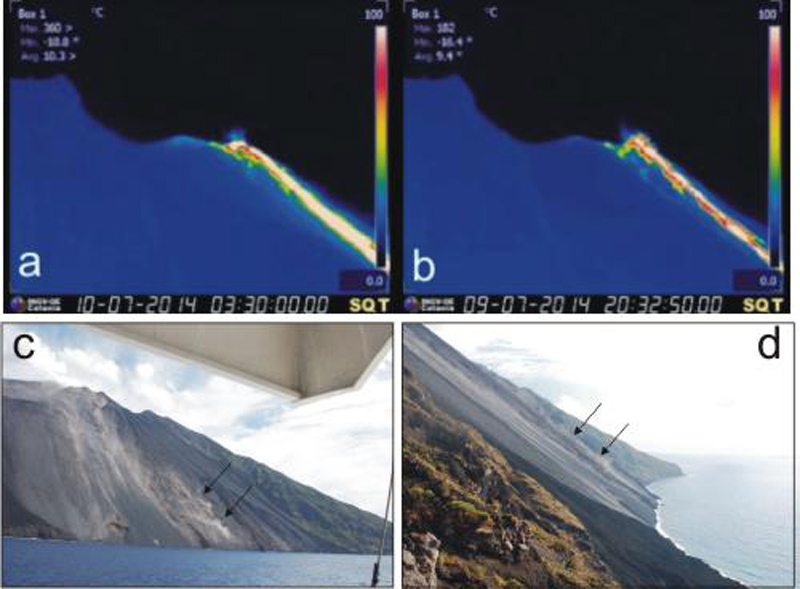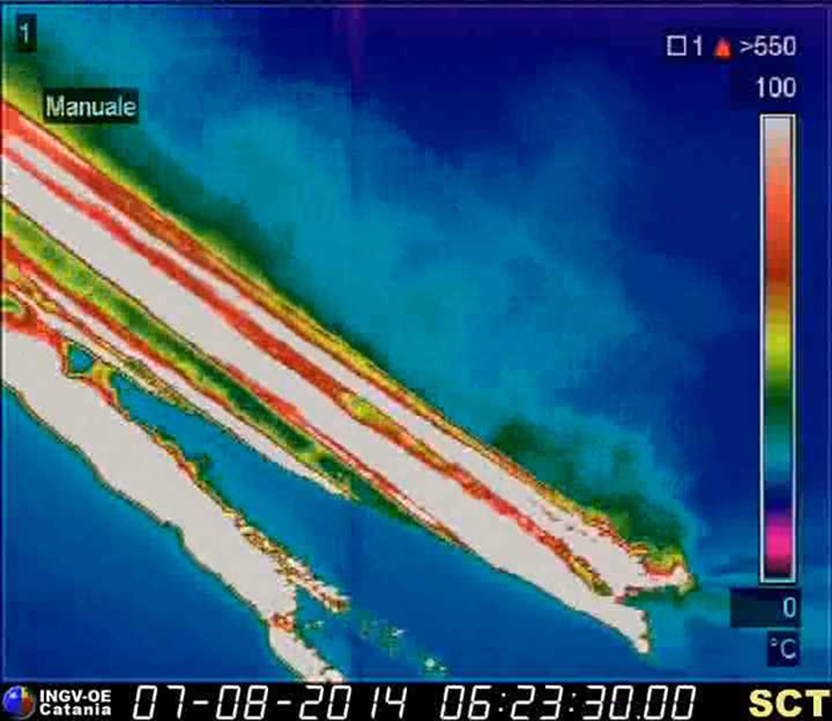Report on Stromboli (Italy) — January 2017
Bulletin of the Global Volcanism Network, vol. 42, no. 1 (January 2017)
Managing Editor: Edward Venzke.
Edited by A. Elizabeth Crafford.
Stromboli (Italy) Ongoing explosive activity during 2014, followed by large lava flows into the sea in August
Please cite this report as:
Global Volcanism Program, 2017. Report on Stromboli (Italy) (Crafford, A.E., and Venzke, E., eds.). Bulletin of the Global Volcanism Network, 42:1. Smithsonian Institution. https://doi.org/10.5479/si.GVP.BGVN201701-211040
Stromboli
Italy
38.789°N, 15.213°E; summit elev. 924 m
All times are local (unless otherwise noted)
Italy's Stromboli volcano, best known for lava fountain eruptions, has been essentially continuously active for at least the last 400 years. Confirmed historical observations of its eruptions go back 2,000 years. Frequent, mild explosive activity in 2013 was accompanied by lava flows and ash plumes (BGVN 40:11). Activity increased significantly during 2014 as reported by the Instituto Nazionale de Geofisica e Vulcanologia (INGV), Sezione de Catania, who monitors the gas geochemistry, deformation, and seismology, as well as the surficial activity. The Toulouse Volcanic Ash Advisory Center (VAAC) reports on ash plumes potentially affecting air travel. The activity at the summit consistently occurs from vents within two well defined north and south crater areas (figure 88) at the head of the Sciara del Fuoco, a large scarp that runs from the summit down the NW side of the island (see BGVN 36:09 for geologic map).
A gradual increase of Strombolian activity from January through May 2014 was followed by small lava flows in June onto the Sciara del Fuoco. Several more lava flows in early July contributed to landslides that sent debris down the scarp into the ocean. In mid-July, four additional flows emerged and traveled down the scarp, with the flow on 19 July reaching the coastline. A strong surge in explosion frequency and intensity in early August caused 300-m-high fountains, followed by lava flows into the ocean for several days between 6 and 13 August. Minor ash emissions in early October sent plumes as high as 3 km altitude. Lava flows continued intermittently into October, but they no longer made it to the coast. Activity diminished significantly at the end of October 2014.
Activity during January-March 2014. After an explosive sequence on 25 December 2013 sent lapilli, bombs, and an ash plume above the summit craters, activity was quieter for several months. INGV reported that a medium-intensity explosive sequence of four events occurred from the S crater area on 4 January 2014. Lava fountaining with lapilli and bombs landing on the S part of the crater terrace and the S and E edges of the Sciara del Fuoco were reported, along with a minor landslide along the scarp. For the remainder of January, fountain explosion heights ranged from low (less than 80 m) to medium (less than 120 m) from the North (N) Area vents. Explosions of lapilli and bombs mixed with ash averaged 2-3 per hour. The South (S) Area vents sometimes exhibited medium-high-intensity (over 150 m) activity with discontinuous spattering, averaging 3-7 explosions per hour.
Only vent N1 in the North Area was active in February 2014. It was characterized by low- to medium-intensity explosive activity, emitting lapilli and bombs mixed with ash at a rate of 2-3 explosions per hour. In the South Area, vents S1, S3, and S4 were active at weak levels with emissions of fine ash mixed with some coarse material, at a rate averaging less than 6 explosions per hour.
Typical Strombolian activity during March included low- to medium-intensity explosive activity from both vent areas. A sequence of three explosions on 7 March from the South Vents led to the fallout of bombs on the upper side of the Sciara del Fuoco. At vent S1 vigorous activity on 14 March produced the rapid accumulation of lava fragments around the vent that flowed downward inside the terrace crater before subsiding. On 17 March small explosions at vent S3 briefly formed a new nearby vent with a persistent thermal anomaly. An increase in SO2 flux was observed in mid-March by INGV. The average frequency of explosions increased in the last week of March to 10-13 per hour, and the seismic amplitudes were also slightly higher in the second half of the month.
Activity during April-June 2014. Lapilli and bombs mixed with fine ash were typical from all vents during April 2014. The South Area had greater activity, with 3 or 4 vents active during the month, although the activity level was generally low- to medium-intensity in both areas. Frequency of events was generally average, ranging from 9 to 15 per hour. Activity in May 2014 was much the same as April in the N Area until the very end of the month when vent N2 began low-intensity explosive activity. All four vents in the S Area were active throughout May. Two intervals of high intensity spattering were reported on 13 and 19 May from the S Area vents. Explosion rates increased slightly during the month to averages of 11 to 18 per hour.
Activity continued to increase in both vent areas during June 2014. Explosions increased to a rate of more than 20 per hour several times during the month, accompanied by longer periods of spattering. Seismic tremor amplitudes also increased beginning at the end of May. Two periods of vigorous spattering led to lava flows. On 17 June, 70 minutes of vigorous spattering from vent S1 fed a lava overflow within the crater that flowed NE for a few tens of meters before cooling. On the morning of 22 June, vent N2 showed a marked increase in both frequency and intensity of activity. It was characterized by vigorous spattering and discrete bursts of high-intensity (over 200 m high) lava jets. The lava flowed from a crack at the edge of the vent and spread to the upper part of the Sciara del Fuoco. It flowed down the scarp for a few hundred meters before stopping early on 23 June. The South Area vents also had explosions over 200 m high beginning on 23 June. A lava flow emerged from vent S1 on 27 June; on 29 June, vent N2 produced two lava flows, the first remained within the crater, and the second, starting in the afternoon, continued flowing into 30 June, reaching the upper Sciara del Fuoco before stopping.
The first anomalies from the MODVOLC thermal alert system using MODIS satellite thermal data in 2014 appeared in early June and increased during the lava flow emissions that occurred at the end of the month.
Activity during July-October 2014. Three lava flows emerged from Vent N2 on 1, 4, and 7 July 2014. The first flowed E for two hours over the 29 June flow within the crater, and was followed later in the day by a second flow that moved towards the Sciara del Fuoco as did the flows on 4 and 7 July. Modest slumping of material around the western portion of the small pyroclastic cone that formed around Vent N2 led to a collapse and landslide that spread rapidly down the Sciara del Fuoco on 7 July. This led to a lava overflow on the upper part of the scarp for several hours during 7 July. Additional lava flows from Vent N2 occurred on 9 and 10 July as large blocks rolling down the scarp coalesced into a lava flow that continued until the evening of 10 July. Small landslides were triggered on the steep flanks of the scarp, and fine debris was carried downslope, almost to the coastline (figure 89).
Four lava flows emerged from vent N2 on 15, 16, 17, and 19 July, while activity at vent N1 continued as low- to high-intensity (up to 200 m high) explosions with lapilli and bomb ejections. The new flows were emplaced just north of the earlier flows. The flow on 19 July made it to the shoreline. Meanwhile, constant spattering and low-intensity explosions continued in the South area at all four vents. The locus of activity shifted during 21 and 22 July from the North Area to the South Area.
During 3 and 4 August, there was a strong surge in explosion frequency to averages of over 30 per hour with peaks of around 100 per hour. This resulted in high-intensity explosions (to over 300 m in height above the vents) from both the North and South Areas. A new lava overflow from the crater terrace began in the early afternoon of 6 August, following the same path down the center of the Sciara del Fuoco as other recent flows. Landslides of hot material quickly reached the coastline, raising large plumes of steam. Pulsating flows of lava later reached the coast and continued flowing into the early hours of 7 August. A new lava overflow from the N Area vents in the early morning of 7 August quickly formed a broad lava field at 600 m elevation and flowed onto the Sciara del Fuoco. Several arms of the lava flowed toward the coast and entered the sea (figure 90).
Lava emissions continued from the N Area vents, reaching the coastline intermittently for several days, fanning out and covering large areas of the scarp, and generating steam jets and explosions with blocks of lava sent tens of meters high as the lava entered the ocean (figure 91). During this time, explosive activity decreased noticeably at the vents, while strong degassing continued. The lava continued to flow along the eastern edge of the Sciara del Fuoco with new flows covering earlier cooling flows as they traveled down the scarp to the coastline until 13 August. Lava effusion continued until mid-October but flows gradually retreated up the scarp, no longer reaching the sea.
 |
Figure 91. Lava flows entering the sea at Stromboli during effusive activity on 10 August 2014. Courtesy of INGV (Stromboli Update, 10 August 2014, 1400 GMT). |
Sporadic ash emissions in early October 2014 led to several reports from the Toulouse VAAC. Ash was reported in the vicinity of Stromboli at a low levels on 30 September, but it was not identifiable on satellite data. It was reported below 1.8 km altitude on 8 October, below 2.4 km on 9 October and below 3 km on 11 October.
A few intermittent MODVOLC thermal anomalies were recorded in July and then substantial anomalies appeared in August, with multiple-per-day continuously during 7-29 August. Almost daily multi-pixel anomalies continued in September and October, but ended abruptly on 28 October. Only one more anomaly was recorded on 8 November 2014. No additional reports on Stromboli were issued by INGV after the 16 October 2014 update.
Geological Summary. Spectacular incandescent nighttime explosions at Stromboli have long attracted visitors to the "Lighthouse of the Mediterranean" in the NE Aeolian Islands. This volcano has lent its name to the frequent mild explosive activity that has characterized its eruptions throughout much of historical time. The small island is the emergent summit of a volcano that grew in two main eruptive cycles, the last of which formed the western portion of the island. The Neostromboli eruptive period took place between about 13,000 and 5,000 years ago. The active summit vents are located at the head of the Sciara del Fuoco, a prominent scarp that formed about 5,000 years ago due to a series of slope failures which extends to below sea level. The modern volcano has been constructed within this scarp, which funnels pyroclastic ejecta and lava flows to the NW. Essentially continuous mild Strombolian explosions, sometimes accompanied by lava flows, have been recorded for more than a millennium.
Information Contacts: Istituto Nazionale di Geofisica e Vulcanologia (INGV), Sezione di Catania, Piazza Roma 2, 95123 Catania, Italy (URL: http://www.ct.ingv.it/en/); Toulouse Volcanic Ash Advisory Center (VAAC), Météo-France, 42 Avenue Gaspard Coriolis, F-31057 Toulouse cedex, France (URL: http://www.meteo.fr/vaac/); Hawai'i Institute of Geophysics and Planetology (HIGP), MODVOLC Thermal Alerts System, School of Ocean and Earth Science and Technology (SOEST), Univ. of Hawai'i, 2525 Correa Road, Honolulu, HI 96822, USA (URL: http://modis.higp.hawaii.edu/).




